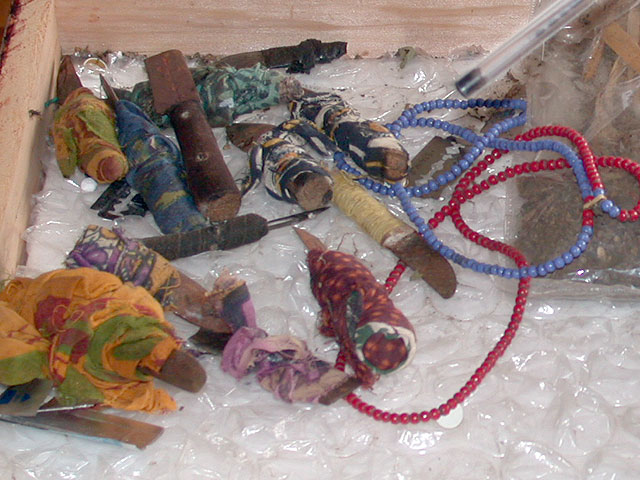
Image by Free-Photos from Pixabay
Female Genital Mutilation (FGM) not only poses serious health risks to women and girls but also exacts a crippling economic toll, according to the World Health Organization (WHO).
What is Female genital mutilation?
FGM known as female genital cutting and female circumcision consists of the (partial or complete) removal of the external female genitalia, and the infliction of other injuries to the female genitalia for no medical reasons.
There are several variations, including partial or complete removal of the clitoris, of the labia minora and majora, the narrowing of the vaginal opening by joining the two sides of the wound, leaving only a small opening for urine and menstrual fluids.
FGM is mostly carried out on young girls between infancy and age 15. FGM can cause excruciating pain, severe bleeding and problems urinating, and later cysts, infections, as well as complications in childbirth and increased risk of newborn deaths.

Knives used for FGM. Source: Wikimedia commons
FGM is viewed as a way to assure that girls remain pure as it is known to diminish sexual pleasure. In some parts of Egypt, husbands insist that their brides undergo this procedure before marriage.
A demographic and health survey conducted in 2014 revealed that more than 40 per cent of respondents believed the practice prevents women from committing adultery.
“FGM is not only a catastrophic abuse of human rights that significantly harms the physical and mental health of millions of girls and women; it is also a drain on a country’s vital economic resources,” said Dr Ian Askew, Director of WHO’s Department of Sexual and Reproductive Health and Research. “More investment is urgently needed to stop FGM and end the suffering it inflicts.”
Treating female genital mutilation costs USD 1.4 billion per year globally
New modelling reveals that the total costs of treating the health impacts of FGM would amount to USD 1.4 billion globally per year if all resulting medical needs were addressed. For individual countries, these costs would near 10% of their entire yearly expenditure on health on average; in some countries, this figure rises to as much as 30%.
The interactive modelling tool that generated these data was launched on the International Day of Zero Tolerance for Female Genital Mutilation.
Severe physical and mental health impacts for women and girls
Women and girls living with FGM face serious risks to their health and well-being. These include immediate consequences after being cut, such as infections, bleeding or psychological trauma, as well as chronic health conditions that can occur throughout life.
Women who have undergone the procedure are more likely to experience life-threatening complications during childbirth. They may face mental health disorders or suffer chronic infections. They may also have pain or problems when they menstruate, urinate or have sexual intercourse.
All of these conditions warrant much-needed medical attention and care.
“High healthcare costs for countries mount because of the tragic personal impacts on women and girls. Governments have a moral responsibility to help end this harmful practice,” says Dr Prosper Tumusiime, Acting Director for Universal Health Coverage and the Life Course in the African Regional Office of WHO. “FGM hurts girls, imposes lifelong health risks on the women they become, and strains the healthcare systems that need to treat them.”
More than 200 million affected
It is estimated that more than 200 million women and girls today have undergone FGM, across 30 countries in Africa, the Middle East and Asia where FGM is concentrated.
The procedure is mostly carried out on young girls between infancy and 15-years-old.
According to a new analysis by the UN Children’s Fund (UNICEF) around 1 in 4 girls and women who have undergone female genital mutilation (FGM) or about 52 million women and girls, were cut by health personnel.
According to WHO, the medicalization of FGM is when it is performed by a health-care provider, such as a community health worker, midwife, nurse or doctor.
The dangers of medicalized FGM were highlighted in the high-profile death of a 12-year-old girl in Egypt last month, prompting international outrage and condemnation by the United Nations and the Egyptian government. Egypt banned the practice in 2008 and increased the penalty for the practice as recently as 2016.
Female genital mutilation endangers the health of women and girls and can lead to long-term physical, psychological and social consequences. While the prevalence of FGM worldwide is down from three decades ago, at least 200 million girls and women alive today have undergone FGM in the 31 countries with available data, and 68 million girls are at risk by 2030. In 2020 alone, over 4 million girls around the world are at risk of being cut.
Can FGM be prevented?
Since 1997, great efforts have been made to end FGM, through work within communities, research, and changes in legislation and policy. 26 countries in Africa and the Middle East now explicitly legislate against FGM, as well as 33 other countries with migrant populations from FGM-practicing countries.
WHO is also working with countries to raise awareness of the harmful impacts of the practice among their health workers, and to engage them in prevention efforts.
“Many countries and communities are showing that abandoning female genital mutilation is possible,” states Dr Christina Pallitto, a scientist at WHO. “If countries invest to end female genital mutilation, they can prevent their girls from undergoing this harmful practice and promote the health, rights and well-being of women and girls.”
Female genital mutilation is internationally recognized as a human rights violation. It has no medical benefits and causes only harm. WHO’s position is that FGM must never be carried out.
Sign up for the QuackTrack.org newsletter below!













